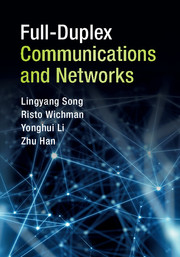Book contents
- Frontmatter
- Dedication
- Contents
- Preface
- 1 Basics of Communication Systems
- 2 Signal Processing and Theoretical Limits
- 3 Full-Duplex System Hardware Implementation
- 4 Full-Duplex MIMO Communications
- 5 Full-Duplex OFDMA Communications
- 6 Full-Duplex Heterogeneous Networks
- 7 Full-Duplex Cooperative Networks
- 8 Full-Duplex Cognitive Radio Networks
- 9 Full-Duplex Random Access Networks
- References
- Index
9 - Full-Duplex Random Access Networks
Published online by Cambridge University Press: 16 March 2017
- Frontmatter
- Dedication
- Contents
- Preface
- 1 Basics of Communication Systems
- 2 Signal Processing and Theoretical Limits
- 3 Full-Duplex System Hardware Implementation
- 4 Full-Duplex MIMO Communications
- 5 Full-Duplex OFDMA Communications
- 6 Full-Duplex Heterogeneous Networks
- 7 Full-Duplex Cooperative Networks
- 8 Full-Duplex Cognitive Radio Networks
- 9 Full-Duplex Random Access Networks
- References
- Index
Summary
Traditionally, the spectrum allocation policy grants fixed spectrum bands to licensed users for exclusive access, which worked well over the past decades. However, with the proliferation of wireless services and data volume in recent years, spectrum scarcity, as a major drawback of this static spectrum allocation policy, has been unveiled. Meanwhile, it is observed that a significant amount of the licensed spectrum is rather underutilized.
As an opposite of the conventional static spectrum management policy, the concept of dynamic spectrum access has been proposed to increase the flexibility in spectrum usage, so as to alleviate the spectrum scarcity problem and improve spectrum utilization. In the existing literature, Dynamic Spectrum Access (DSA) models can be categorized as follows: exclusive-use, shared-use, and commons models. In the exclusive-use model, a licensed user can grant an unlicensed user the spectrum access rights to have exclusive access to the spectrum. In a shared-use model, an unlicensed user accesses the spectrum opportunistically without interrupting a licensed user. In a commons model, an unlicensed user can access the spectrum freely. DSA can be implemented in a centralized or a distributed network architecture. DSA can be optimized globally if a central controller is available in the network. On the other hand, when a central controller is not available, distributed algorithms would be required for dynamic spectrum access. Issues related to spectrum trading, such as pricing, will also need to be considered for dynamic spectrum access, especially with the exclusive-use model. For DSA-based radio networks, MAC protocols designed for traditional wireless networks have to be modified to include spectrum sensing, spectrum access, as well as spectrum trading between a licensed user and an unlicensed user.
Most current dynamic spectrum access paradigms are designed for HD devices with the basic assumption that data transmission and reception of any devices must be separated in the time or frequency domain. Recently, with the rapid development of self-interference suppression techniques, FD communication rapidly extends its application to different scenarios. In FD communications where co-channel simultaneous data transmission and reception becomes possible, many more possible communication modes among communication devices arise. For example, two FD devices can perform bidirectional transmission to each other; one FD devices can receive data from a source, and transmits data to another destination concurrently on the same channel.
- Type
- Chapter
- Information
- Full-Duplex Communications and Networks , pp. 291 - 311Publisher: Cambridge University PressPrint publication year: 2017



